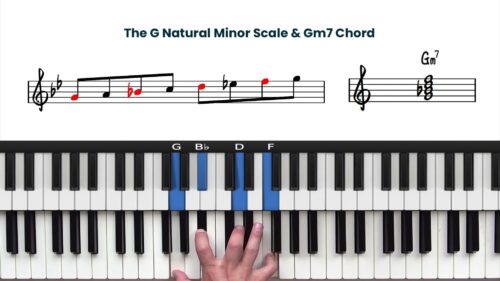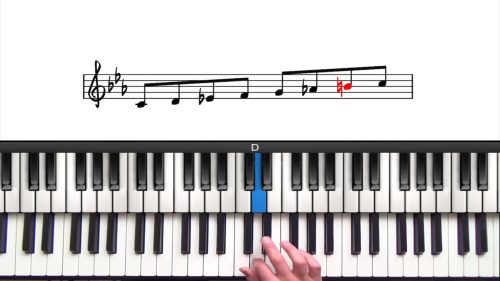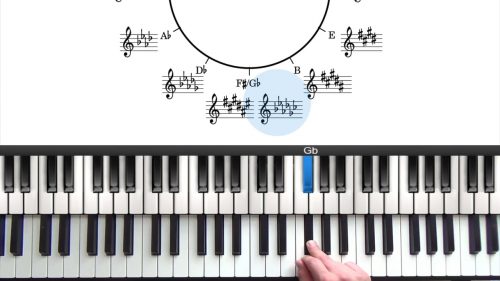Major & Minor 9th Chords Drill
Welcome to this practice plan lesson for the course on Extended Chords & Voicings. After watching the lessons in this course, you will now have a basic understanding of where extensions come from, and you should also be familiar with some useful extended chord voicings such as the So What Voicing, The Herbie Hancock Voicing, and the Kenny Barron Voicing.
In these 3 lessons, we will run over 6 exercises that will help you visualize and memorise the upper extensions for major, minor, and dominant chords.
The 9th Chord Extension & How To Practice It!
The 9th is the first of the upper extensions 9, 11, & 13 and so it makes sense for us to isolate and work on this one first. For this practice slot, we are just going to cover major and minor chords, and then in the next exercises, we will also introduce dominant chords and the full 251 progression.
For the first drill, we are going to build the major and minor 9th chord. We’ll stack 3rds from the root up to the 9th and move around the circle of 5ths.
Right Hand: Open & Closed Position
There are 2 very useful right-hand inversions of this chord. What we just covered is the ‘open position’, and we can also create a ‘closed position’ right-hand voicings containing the 3, 5, 7, & 9.
There’s a couple of different ways to find this inversion, the first is to take the sequentially stacked voicing we had in the last drill, and now put the bottom 2 notes in our right hand on top.
The second method – which I actually prefer – is to memorise the scale degree construction. We always play the root in our left hand, and then from bottom to top, our right-hand plays 7-9-3-5.
Circle Of 5ths Drills
The final 2 exercises mix these open and closed position RH voicings together and incorporate voice leading when moving around the circle.
Starting with major 9 stacked thirds, and then alternating. Now let’s reverse that pattern, and start with the closed position right-hand.
And then let’s repeat the same for minor chords – first starting with the minor 9th stacked 3rds and then start in the other inversion.
Lesson Downloads
-
Chord Extensions Practice Plan File Type: pdf
Practice Tips
-
Learn both inversions of the 9th chord in all 12 keys by taking it around the circle of firths.
-
Listen to the difference between the 7th chord, and the added 9th chord. It creates a richer 'colour' and 'texture'.
-
Once you are comfortable with both inversions, then put them together in the alternating circle of fifths drill. Do this for both major and minor chords.
- There are other inversions for these chords, but those are the most important for you to visualize so learn and memorise these voicings first.








When would you say I should start the next course?
Hi Idan,
I recommend that students study multiple courses at once, so certainly explore the next courses which are “Rootless Harmony” and “Altered Harmony”.
You can alternate the practice plans each day, or perhaps 2 days on the chord extensions practice plan, and then 1 day on the rootless voicings practice plan. Find a combination that works for you.
In the upcoming courses, we are always referencing the previous theory. If you don’t understand you can always come back to the earlier courses.
All of your courses are saved to your student dashboard so you can find them easily.
You can also use our lesson bookmarking feature to save specific lessons to your dashboard, add notes, and then revisit that specific lesson in the future.
I hope this helps and if you have any other questions let me know.
Cheers!
Hayden
Should 1 key be covered with every practice lesson or should one go around the entire circle everytime they arr going to practice this drill? Thanks!
Hi Jose,
The goal is to eventually take the exercise around all 12 keys in 5 minutes.
Perhaps when you start out with the exercises, it might take 5 minutes to go through just 2 or 3 keys, and that’s no problem. Next time perhaps you can get through 4, keys, then 5, etc….
To start with I would also recommend splitting the keys into groups of 3 or 4. Then alternate through these keys, you can see more information on this here in the forum where I recommended a student on major scales: pianogroove.com/community/t/difficulty-memorizing-all-numbers-in-all-scales/3517/3
I hope this helps, let me know if I can be of further assistance.
Cheers,
Hayden
It did. Thanks a ton!
Hi Jose 👋🏻
Glad you enjoyed the lesson!
Cheers,
Hayden
The natural minor of C is E♭, so can you also think of Cmin9 by playing the root C in base with an E♭Maj7 on top? Similarly Fmin9, F with A♭Maj7 on top?
Hi Mark 👋🏻
Great question.
I think you meant “the natural major of C minor is Eb” and yes that is true.
And yes, we can use this as a short cut to find the rootless voicings, but as soon as possible, the goal is to see that Ebmaj7 as the b3, 5, b7, and 9 of Eb major. And the same for all of the other keys.
By all means use this relationship (major 7th chord a minor 3rd up, or major 7th built off the relative major) to help you initially see the voicing shapes, but every time you do this, play each note and say the scale degrees out loud in relation to the root note, using the example above for C-9, Eb is the b3, G is the 5, Bb is the b7, and D is the 9th.
This is very important to start visualising those tones in relation to C Minor, which is the chord we are playing.
As we explore in other lessons in this course, we also have the 11th and 13th. We could look at a C-13 voicing as a D minor triad over C-7 in the left hand, or minor triad built from the 9th, so there are many little shortcuts like this, but the important thing is that we are seeing the extensions in relation to the root note.
This can be a little tricky to explain so I hope the above makes sense.
We also have a forum thread on rootless voicings here which you may find insightful:
pianogroove.com/community/t/understanding-rootless-voicings/945/
I hope this helps Mark, and any further questions you can post them here or in the community area.
Enjoy playing around with this stuff.
Cheers,
Hayden
I can see a major triad being built off the 5th. Any benefit of seeing it this way? Any better way of seeing it? Will it be confusing (more memory crunching) when I add the 11th and 13th which form another triad off the 9th?
Hi Dan,
I can appreciate that this seems a little daunting at first but I guarantee with practice that it becomes much easier.
There are many ways that we can subdivide a voicing.
As you say, for Cmaj9 we could say a major triad built off the 5th.
I think an easier way to look at this would be to visualise a minor 7th chord from the major 3rd. So for Cmaj9, we would have and E-7 chord over C.
Now in reality, this is all Cmajor, but if when starting out this helps you to visualise the shapes, then that is fine.
You must understand that Cmaj13 is simply all of the notes of the C major scale but not placed in step-by-step order.
There are lots of tricks for learning cool voicings, for example if we play Cmaj7 in our left hand, and then a D Major triad in the right hand, we then have Cmaj13#11. We can also look at this as a major triad built off the 2 or 9 of the chord.
At this stage, the most important thing for you to do is to develop an awareness of the extensions.
When you play Cmaj9, instead of thinking a G major triad off the 5th you should identify each note that you are playing.
The notes of Cmaj9 are C-E-G-B-D
and so stop and work through each note and say “E is the 3rd”, “B is the 7th”, “D is the 9th” etc…
With a little practice you will start to visualise the extensions as part of the C major chord, and we must do the same with minor and dominant chords.
Doing this in the context of the 251 is also more efficient. As you move through each chord in the extended 251 progression, stop and analyse the scale degree of each note you are playing. For the dominant chords this is tricky as they often include both the 9 and the 13, but I promise that with practice this will become second nature.
I hope that helps Dan and let me know if you have any further questions.
Cheers,
Hayden
Thanks Hayden. I can’t wait to have that second nature you mentioned.
I come from a ballad style 1-5-8 LH voicing so incorporating 7,9,11,13 is daunting for my current skill.
I practice the extension drills a lot now and I’m beginning to see and feel the shapes and i think i’ts freeing up my brain.
Btw, I like that cool trick you shared , LH Cmaj7 , D Major triad RH for Cmaj13#11 C-E-G-B-D-F#-A (as opposed to minor 7th chord off the major 3rd as I’m struggling with minor chords).
Hi Dan,
Yes it is a gradual process but with a regular daily practice routine you will see rapid improvement.
My main piece of advice is to go through the extended 251 progressions in all we keys where we play the following extensions:
ii-9 / V13 / Imaj9
and for each chord go through each note individually and identify what that note is in terms of scale degrees relating to the underlying harmony.
This is particularly challenging for the V13 chords as we have both the 9 and the 13 in the voicing. As mentioned this will become natural.
Did you tune into my last live seminar on 251 progressions? .Check out the recording here: pianogroove.com/live-seminars/251-progressions-jazz-standards/ – that is a nice seminar to see how the 251 develops from simple construction to advanced.
Finally, If you like the trick with the right hand triad, you might like to check out my short masterclass here on Upper Structure Triads: pianogroove.com/jazz-piano-lessons/what-are-upper-structure-triads/
This is a more advanced topic but I think it’s always nice to ‘get our toes wet’ in some more advanced theory.
We have a full dedicated course on this topic here: pianogroove.com/jazz-piano-lessons/altered-harmony-upper-structure-triads/
After you have completed this course on chord extensions, I’d recommend the “Mastering Left Hand Voicings” course, and then the “Altered Harmony” course above. By that point you will have covered a large chunk of jazz harmony and theory.
Also remember that you don’t need to play all of the practice exercises flawlessly before moving on to the next course, just revisit them from time to time by alternating the practice planners. So much of the theory is repeated and developed in the subsequent courses that we are constantly revisiting the theory covered in this course.
Have fun with this stuff Dan!
Cheers,
Hayden
Very helpful links. Thanks Hayden.
Whoa, I was just practicing taking the major 9th chords around the circle of fourths and realized something pretty cool. The top three notes of each maj9 chord (in open position) is actually the major triad of the previous key in the circle 😳
So in open position, the Cmaj9 chord is Root, maj 3rd, and a Gmaj triad on top. And then Fmaj9 is a Root, maj3rd, and a Cmaj triad on top, and so forth, all the way around.
Hi Hayden,
Would it be possible to create a pdf for us to summarize the voicings you covered in the lesson with notation? I don’t need it in all keys of course. Just enough examples for a reference sheet.
Great lesson!
Thanks!
Hi David,
Yes I can certainly create a PDF file for this lesson which shows Type A and Type B in a few different keys.
The most important thing is to be visualising the chord tones so find the 7th chord, and say to yourself, “here is the root, 3rd, 5th, and 7th” and then find the 9th (which is also the same note as the 2nd degree of the scale). By doing this continually we are able to visualise the tones on the piano which is the point we must get to.
Also we do have a jazz voicing chat sheet here which contains some useful voicings: pianogroove.com/wp-content/uploads/2015/11/Common_Voicings_Cheat_Sheet.pdf
I will create the new PDF file for you asap and add it to the download section of this page.
Cheers,
Hayden
Is there a simplified practice planner, in a similar vein to the jazz foundations one?
Hi Samuel,
Thanks for getting in touch.
Yes I can certainly create a simplified practice planner, that’s a great idea.
The most important drill or ‘outcome’ from this course is to be able to play the extended 251 progression in all 12 keys.
This is demonstrated in this lesson: pianogroove.com/jazz-piano-lessons/extended-251-progression-drill/ in our Whole Step 251 Course.
The drills covered in the practice planner are preliminary steps to the above drill, where we isolate the major and minor 9th chords in type A and type B, and so those drills are important.
Leave it with me and I will devise a simplifies practice planner.
Any other questions just let me know.
Cheers,
Hayden